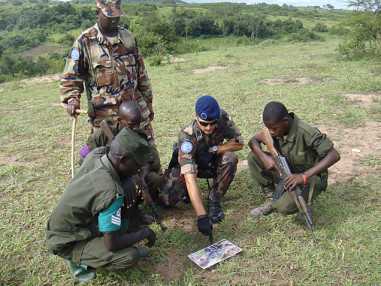Second Phase of Training Ends in Uganda
Szöveg: 1LT Péter Csatlós | 2012. november 12. 10:06The second eight-week training phase of the EUTM Somalia mission focused on tactical movements, the coordination and conduct of operations and making contact. In this phase, the Somalis participated in increasingly fewer classroom instructions, but by now they have took several hundred hours of hands-on training sessions. Reporting from the spot.

During this period, the task of the Hungarian–German training team was to mentor the NCOs of the combat units of Somalia, which involved many live fire exercises. Compared with the target practices of the basic training, a significant difference is that the soldiers did not only have to fire from a given distance but they also carried out increasingly complex movements on each range day. While doing so, they had to watch themselves and their targets while coordinating their own fireteams.
The young men arrived here four months ago, often after being recruited from the streets of Mogadishu with no previous education. By now they have entirely got used to the intensive and hard training program. Like the European troops, they do not find it easy to adapt themselves to the climate. Temperatures in Somalia are somewhat higher, and there are less rain – especially in the region of Mogadishu, because there may be severe droughts near the ocean coast. In the equatorial region of Uganda, the site of the training, showers and raining are quite common when the rainy season sets in. Of course, this can make the training more difficult, but the work must go on.
Fortunately, the trainees have realized the seriousness of the situation. It took the trainers a lot of effort to take the soldiers to a certain mental level. Today the Somalis are proud of their chosen vocation, the process that they have gone through so far, and they feel they are true soldiers. They also know that when they return home in around two months, they will immediately be deployed in live combat situations.

The AMISOM forces in Somalia are beginning to recognize the soldiers trained by the Europeans. Some say that this is one of the best-trained personnel among all the militias in the region. Without the troops of the Somalian National Armed Forces (SNAF, known earlier as Transitional Federal Government (TFG) trained in Uganda, the local forces would never have been able to fight against the Al-Shabab terrorist organization as effectively as they are doing it now. Day by day they secure victories by recapturing towns and ports from under the control of Al-Shabab.
The election of Hassan Seik Mohamud, a new president in Somalia after twenty years and the replacement of the transitional government by a permanent one is another major step forward.

To form this government, it is essential to have a well-trained military organization for him to rely on. In this field, the European soldiers’ contributions will never be forgotten, as they are tirelessly working to set up an effective military force thousands of kilometers away from their home. Hopefully sooner or later the SNAF will be able to train its soldiers for itself, based on the skills acquired in the Bihanga Training Camp (BTC).
Besides the intensive training, it is also important to maintain good relations with the local people. The Hungarian personnel are doing their share of this CIMIC activity as well. On the most recent occasion, Maj. Dr. Tibor Steiner, the national senior officer entered the 10-kilometer Kids of Africa Fun Run field running race, which was held in the vicinity of Entebbe. Of the 84 entrants, Maj. Steiner came in seventh, which is a distinguished placing and a good result in itself, and the best result among the competitors sent by the EUTM Somalia. The proceeds from the entrance fees of the competition will go to charity. The organizers would like to spend the collected money on starting the construction of an elementary school for the Kids of Africa children’s home.
Photos by the author